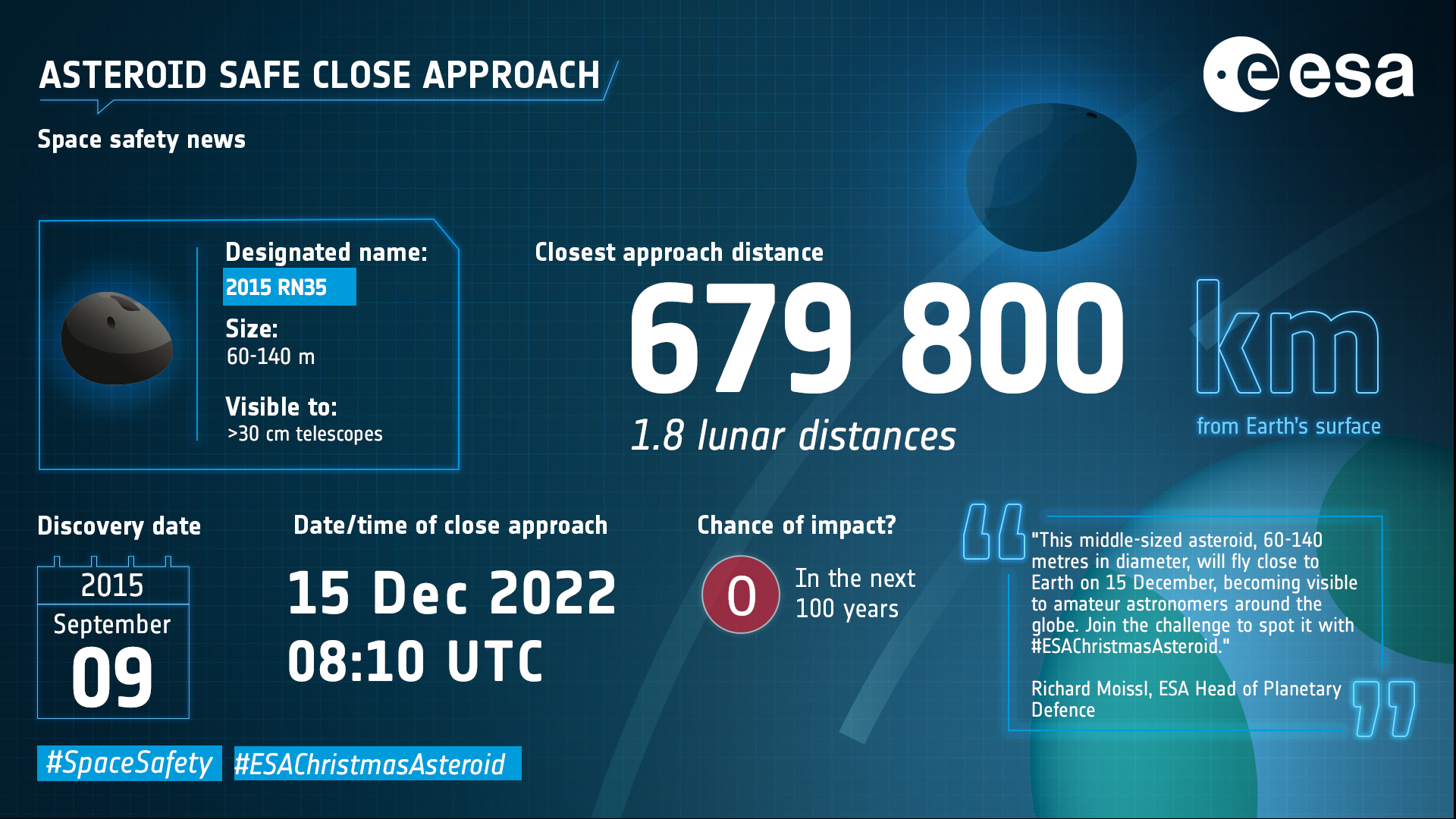Amateur astronomers challenged to spot an asteroid for Christmas
The asteroid 2015 RN35 could be the size of the Great Pyramid of Giza and will safely pass Earth on Thursday (Dec. 15), giving skywatchers an opportunity to spot it.

On Thursday (Dec. 15) an asteroid will make a close approach to Earth, and amateur astronomers have been challenged to catch a glimpse of what the European Space Agency (ESA) is calling the "Christmas asteroid."
At 3:12 a.m. EST (0812 am GMT) the asteroid, designated 2015 RN35, will come its closest to our planet passing within around 430,000 miles (686,000 kilometers), which is just under the distance to the moon and back.
The challenge to spot the Christmas asteroid has been made by ESA to mark the release of their new asteroid toolkit. It offers skywatchers an exciting opportunity because, despite the fact astronomers know 2015 RN35 will safely pass Earth, little else is known about the asteroid.
Related: Night sky, December 2022: What you can see tonight [maps]
The asteroid, which has an estimated size of between 200 to 460 feet (60 and 140 meters) that makes it about the size of the Great Pyramid of Giza, will be visible between the day of its close approach until Monday (Dec. 19). It has a visual magnitude of around 14, similar to that of Pluto, meaning it should only be viewable with telescopes that are 30 centimeters (11.8 inches) and larger.
"This asteroid isn't well known," the ESA writes in a statement. "We don't know what it's made of or precisely how big it is or if it's spinning on its axis or even know its orbit particularly well. (Enough to know it won't strike in the next century!)."

Want to try to spot the Christmas asteroid for yourself? You're going to need a telescope. We recommend the Celestron Astro Fi 102as the top pick in our best beginner's telescope guide.
This uncertainty applies to hundreds of thousands of mid-sized asteroids around Earth. These more diminutive space rocks may not be capable of the kind of devastation associated with massive "planet-killer" asteroids — which thankfully are well documented — but could still do a great deal of damage to local areas if they impact Earth.
Breaking space news, the latest updates on rocket launches, skywatching events and more!
That means astronomers are particularly interested in asteroids like 2015 RN35 which are classified as Near-Earth Objects (NEOs) because their study can grant insights into a class of objects that present a risk of impact, so-called Potentially Hazardous Objects (PHOs).
Read more: Asteroid apocalypse: How big must a space rock be to end human civilization?
The ESA's NEO Toolkit, created by its Near-Earth Object Coordination Centre (NEOCC) based in Rome, offers space enthusiasts a great opportunity to experience how space agencies investigate asteroids, whether NEOs or PHOs, to aid Planetary Defense.
"We use these tools every day to plan our observations, to visualize asteroid close approaches, and to help us understand and explain the varied asteroid populations in the solar system and the risk we face," Information System Manager at the NEOCC, Juan-Luis Cano, said. "We want them to be as useful to the rest of the world as they are to us because Planetary Defense is a global effort."
Read more: Scientists spot 10,000th medium near-Earth asteroid in planetary defense milestone
Even if members of the public aren't willing to brave the December cold to spot 2015 RN35, they can use the NEO Toolkit to visualize the Christmas asteroid's orbit and Thursday's flyby.
The toolkit's users can also check if it will be visible from their location on the globe as well as learn more about the Apollo asteroids, the family of space rocks that 2015 RN35 belongs to.
If you manage to spot an image of the asteroid 2015 RN35 you can share your observations of the space rock on social media using the hashtag #ESAChristmasAsteroid, adding information about yourself and where you are located.
The NEO toolkit is available at neo.ssa.esa.int/neo-toolkit.
Editor's Note: If you snap a picture of the asteroid 2015 RN35 and would like to share it with Space.com's readers, send your photo(s), comments, and your name and location to spacephotos@space.com.
Follow us on Twitter @Spacedotcom or on Facebook.

Robert Lea is a science journalist in the U.K. whose articles have been published in Physics World, New Scientist, Astronomy Magazine, All About Space, Newsweek and ZME Science. He also writes about science communication for Elsevier and the European Journal of Physics. Rob holds a bachelor of science degree in physics and astronomy from the U.K.’s Open University. Follow him on Twitter @sciencef1rst.


